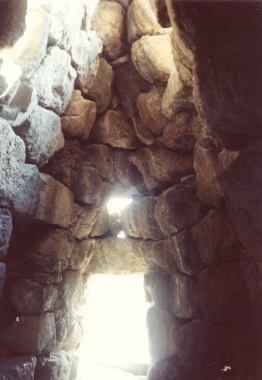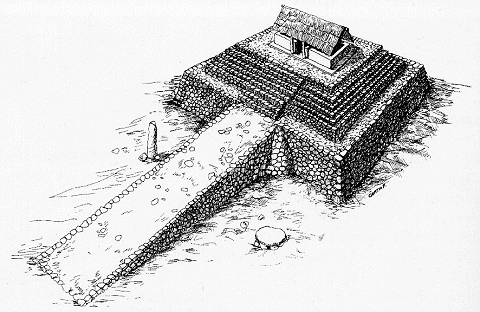THE SARDINIAN MEGALITHISM
To the eyes of our generations, it is amazing to become account like the prehistoric man, and, in particular, the man of the neolithic or the metal age, was already totally in possession of deepened astronomical acquaintances.
Several and numerous megalithic structures exist in Sardinia, already beginning from the neolithic and until to the archaic age. Well, in their disposition on the territory, they have been verified and assessed a series of astral alignments, that, also in the incompleteness of the searches and the studies, still to a beginning phase, demonstrate the possession of such acquaintances by the ancient Sardinian man.
Here is a short prospect of the tipology of such monuments, distinguished by edification and use prehistoric age.

Barumini: central nuraghe, complex 1
THE NEOLITHIC AGE
The Mount of Accoddi Sanctuary /SS
In neolithic age Sardinia was still sporadically populated. The more imposing remained monument is an altar/sanctuary in locality Mount of Accoddi near Sassari; in it they have been characterized two constructive phases: 1st phase, or “red temple” phase, 3200 b.C., and 2nd phase, or real temple-altar phase, just datable on 2900 b.C. In the 2nd phase, the total dimensions are 37,5x30,5 ms. To the terraces it is approached with one large flight, that measures 41,50 ms.
The tipology of the Mount of Accoddi Sanctuary is not found in European within; in fact it would seem an example of the Mesopotamic model of ziqqurrath, even in the 1st phase it consists of a single terracement and in the 2nd phase two single ones. The altar is astronomically oriented towards north; it could therefore has been used after religious functions connected with the polar star. Such bearing is not found in European within. It is not possible moreover to make suppositions on the function of the present outside megaliths ones, because moved in the centuries: a 2900 b.C trapezial big slab supported on three stones, like a small dolmen, with seven small going back cavities at the edges; a more small slab of 3200 b.C.; a large stone of perfectly spherical shape, on the whose surface is carved with numerous little cavities, representing - perhaps – some constellations; one menhir high 4,44 mts., attributable at the 1st phase.

The Mount of Accoddi Sanctuary
Two altars at Pispisu/Abbasanta and Riu/Aidomaggiore
Carlo Maxia and Lello Fadda have carried out geometric measurements on others three altars near Oristano, they have assumed their solstice bearing. In particular, the altars of Pispisu/Abbasanta and Riu/Aidomaggiore seem revolts towards the winter solstice sunrise, with an approximately error of 3°, while the altar at Costaleri/Ghilarza seems to be oriented towards the summer solstice sunrise, also it with an approximately error of 3°. The direction of the winter solstice sunrise could be reconnected to the religious cult of the resurrection; more uncertain it is the meant one of the bearing to summer solstice sunrise, perhaps connected to the cult of the birth or the fecundation.
|



